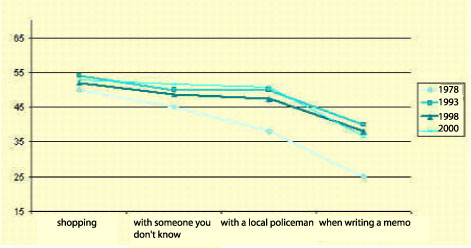
| Sociolingüística catalana |
| Linguistic uses and identity in
Catalonia, by Albert Fabà, Olga Gàlvez, Joan Manrúbia and Noemí Ubach |
||||
| CONTINUA |
The question asked was "which language do you mainly speak when...: you go shopping, you ask someone you do not know for information, you speak to a local policeman, at work, with the neighbours, with friends and when you write a memo". The answer options were not read but, even so, a proportion of the interviewees answered "both Catalan and Spanish", and did not prioritise one language over the other. The first observation to make is the difference between the oral cases and the only situation that requires a certain level of writing skills. Whilst the main language of use for the first six situations is Catalan (around 50%), the majority write memos in Spanish, 53.8% to be more accurate. This is borne out by the significant percentage of individuals who still do not know how to write in the territory’s own language -54.2%, according to data from the 1996 census. Secondly, although the variations – which range from 52.9% for use in shops to 44.3% with neighbours (approximately nine points difference) – are not very great, it would appear that Catalan is mainly used in more impersonal and "official" situations, whilst it is used less in situations involving a higher level of personal acquaintance. This fact also seems to be associated with a stronger use of both languages in these latter cases. This probably does not mean that we use a mixture of Catalan and Spanish to communicate with a particular neighbour, but rather that we speak to some neighbours in Spanish and to others in Catalan. The same occurs at work or with friends. It also depends on the circumstances of your meeting the person in the first place. It is well-known that it is very difficult to change the language you use to communicate with a person that you met using a different language. The stronger the emotional intensity of the relationship, the more difficult this change becomes. Finally, the second option is always Spanish, which oscillates between 30% and 40%, depending on the variation of the third category, both languages, since the two lines are clearly asymmetrical: when one rises, the other drops, and vice versa, except in more "personalised" situations (with neighbours or friends), where both languages increase to the detriment of Catalan, and not Spanish, which remains the same. It is important to try and discover how this use has evolved over recent years. We can do this using the results from a number of years, with practically the same or very similar questions (1978, 1993 and 1998, using the CIS surveys; 2000, with that of Fabà et al.), as revealed in Figure 9. Figure 9.
Individuals who mainly use Catalan, in a range of contexts. 1978, 1993, 1998 and 2000.
Percentages Source: CIS 1978, 1993 and 1998, Fabà et al. 2000 As we can see, the results throughout the last decade are very similar, since the differences occur because of the range of situations, and not so much because there has been an increase or decrease in the social use of Catalan. However, there are important contrasts between 1978 and 1993, particularly in the last two cases, which reveal a significant increase in use. It is interesting to intersect the data contained in Figure 9 with those of linguistic identity. |
